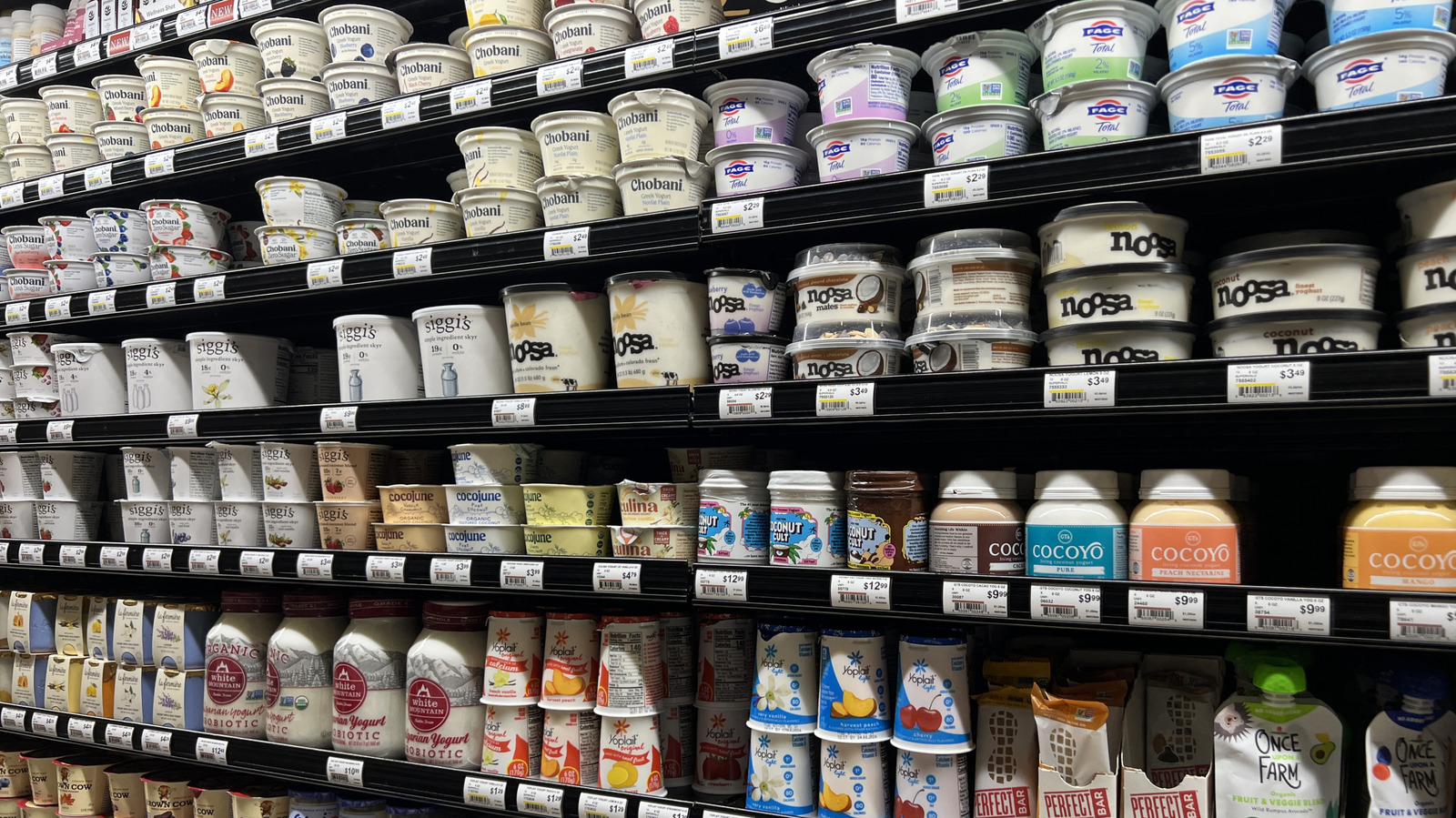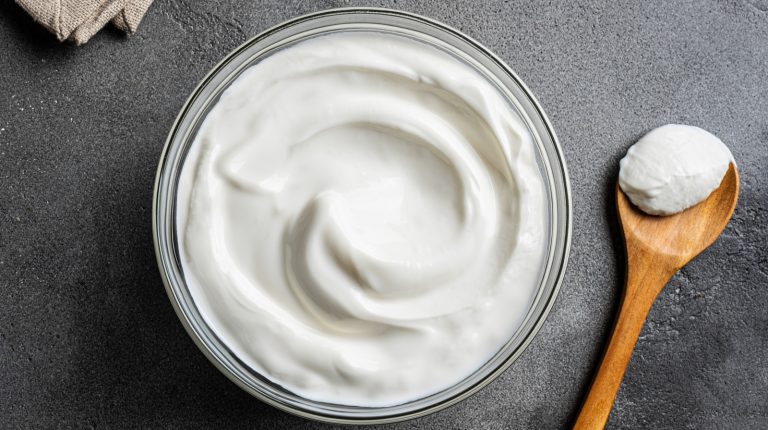Picture this: You’re flipping through your cookbook and land on a delicious looking recipe. The ingredient list is approachable and straightforward … until you land on the word “yogurt.” That single word is deceptively simple, since you know the dairy aisle has countless styles in nearly infinite flavors. So, should you go with Plain Jane standard yogurt? What about Greek? Haven’t you heard of Icelandic yogurt? Would that even work? Does anyone actually know what it all means? Suddenly, it all feels too overwhelming, and you turn the page to look for a new recipe.
But if you’re armed with the right information, that situation never has to come to fruition. Go ahead and read on to learn the basics about 12 of the most common styles of yogurt. Below, you’ll learn what makes Greek yogurt different from Australian or French, as well as the taste and texture of whatever yogurt you might encounter during your next trip to the supermarket. So, the next time you see the word “yogurt” in your cookbook, you’ll know just what kind to grab.
Conventional American yogurt
Live bacteria ferments milk to make conventional American yogurt, and it’s the kind of yogurt most commonly spotted at supermarkets across the United States. No whey (liquid byproduct of curdled milk) is strained from conventional yogurt, which results in a looser consistency and a lighter texture. Because of the higher whey content, you can expect conventional American yogurt to have more sugar and less protein than strained yogurts, like Greek.
That higher sugar content also results in a more mild flavor, making conventional American yogurt some of the sweetest you’ll find in the dairy aisle. Beyond being a fridge staple perfect for a quick snack or the base of a satisfying and sweet breakfast dish, regular ol’ yogurt is an incredibly versatile ingredient. The fermented milk product works well in recipes for creamy and tangy sauces, moist and tender baked goods, and as a marinade to tenderize even the toughest steaks.
Greek yogurt
The process for making Greek yogurt is mostly the same as that of traditional yogurt, except for one key step. Greek yogurt undergoes straining to remove liquid whey to create a much thicker, creamier texture than that of regular yogurt, as well as a tangier, more sour taste.
Aside from the texture and taste, straining the product also concentrates the dairy product’s protein content. The next time you’re at your neighborhood grocery store, take a look at the nutrition information on the tubs of conventional American and Greek yogurts. The Greek yogurt will undoubtedly have a higher protein content – usually about twice that of the basic yogurt. This makes it a great choice for athletes or folks conscious about their protein intake. But don’t just haphazardly snag a container from the dairy aisle, make sure you know the best and worst high-protein yogurt to buy at the grocery store.
Labneh
Labneh (pronounced “leb-ney”) is another strained yogurt product, but it’s even more concentrated than Greek yogurt. It’s made by salting plain Greek yogurt and straining it through cheesecloth for many hours in the fridge to remove excess liquid. The resulting product has a much thicker texture and cheesier taste than other products in the yogurt family.
With deep roots in Middle Eastern cooking traditions, labneh is often used as a dip or spread for pita bread or veggies. It’s a pretty versatile item to have in your kitchen, and it can be used in place of cream cheese in certain recipes – just be cognizant of the extra acidity it’ll bring to a dish. But if you’re still not sure about this thick and delicious dairy product, try using it in a lower-stakes situation, like as the mayo-free swap you need for a rich, creamy tuna salad, or lean into that cheesiness and acidity by incorporating it into your favorite onion dip recipe.
French-style yogurt
Unlike other yogurt varieties, French-style yogurt is made in small batches. So, those tiny glass jars you see at your local grocery store? The yogurt was made directly in those vessels rather than in a larger container and dished out. This process (along with a simplified ingredient list) is meant to imitate the methods used in the French farmhouses of the early 1900s, which didn’t have the same mass processing capabilities as modern facilities.
This process means that French-style yogurt is firmer than conventional varieties. The product is also made with whole milk, which, beyond its contributions to French-style yogurt’s consistency, also imparts a milder, less tart, and tangy flavor with undercurrents of sweetness.
Oui by Yoplait is the biggest player in French-style yogurt at grocery stores across the United States. Beyond the novelty its glass jars provide, the brand also has some pretty interesting and popular flavors.
Icelandic yogurt (Skyr)
Icelandic yogurt, also known as Skyr (pronounced “skeer”), will be located in the yogurt aisle alongside common conventional and Greek varieties. But despite its label as “Icelandic yogurt,” it’s not actually considered yogurt since beyond the cultures typical of yogurt making, Skyr includes the addition of rennet – an enzyme regularly used in the cheese-making process. Nevertheless, it’s still in the fermented milk product family, so you can keep calling it yogurt if that floats your boat.
This product’s origins date back to over a millennia ago, possibly stretching back even further than when Vikings colonized Iceland. And beyond its rich history, Skyr also has a rich texture. And when you taste a spoonful of it, you’ll probably be reminded of Greek yogurt but with a bit less tang and a bit less sweetness. So if you’re into milder flavor but a thicker, creamier texture, go with Skyr.
Bulgarian yogurt
Bulgarian yogurt gets its uniqueness from the two specific bacteria that are used in its production – Lactobacillus bulgaricus and Streptococcus thermophilus. While most yogurt varieties contain these two bacteria, they also tend to chuck in some other live cultures. Bulgarian yogurt, however, relies on that particular combination, with the Streptococcus thermophilus being activated first to develop the right conditions for the Lactobacillus bulgaricus.
In Bulgaria, the product is actually called “sour milk” and, based on its flavor, that’s not exactly surprising. Bulgarian yogurt does in fact have a more sour flavor, and its tartness exceeds that of the notoriously acidic Greek yogurt. Bulgarian yogurt is also different from its Greek peer in that it remains unstrained. This makes for a slightly looser yogurt that’s an ideal base for use in cold soups or, when diluted a bit, a refreshing beverage. You can, of course, also just spoon it straight out of the pot if you’re looking for a no-frills boost of probiotics.
Australian yogurt
Australian yogurt falls somewhere between conventional and Greek yogurt on the thickness spectrum, but while Greek yogurt achieves its consistency from straining out excess liquid, the dairy product by Down Under takes a different approach to processing.
Australian yogurt is unstrained, but to give it that velvety texture, the fermented milk product is cooked slowly for a long time in order to let the dairy thicken gradually. As far as flavor goes, it’s got a bit of acidity to it, but on the whole, Australian yogurt is on the milder side. You’ll often find Australian yogurt comes pre-sweetened with honey, which adds to the luxurious, dessert-like vibe. This makes Australian yogurt an ideal choice for anyone looking for the health benefits of the fermented milk product but without the characteristic tang and sourness that accompanies many other yogurt varieties, like Greek. It’s an ideal product for sweet breakfasts like smoothies, parfaits, or even overnight oats, but unsweetened versions will also work well in savory applications.
Kefir
You’ll likely spot kefir (pronounced “kuh-feer”) among the yogurt and yogurt drinks at the supermarket. While there may be products marketed as “kefir yogurt,” that’s not exactly a real thing. Kefir is a healthy, yogurt-like beverage chock full of probiotics, and it’s made of fermented milk, just like yogurt. However, the key differences come in the consistency and bacteria used to make the product.
Kefir is a beverage and, therefore, has a thin, drinkable consistency – a departure from your average yogurt, which is thicker and needs to be eaten with a utensil. And even though it’s under the same umbrella as yogurt, it isn’t exactly the same thing thanks to its unique good bacteria, Lactobacillus kefiri, which is the key to creating the fermented milk product. In terms of flavor, kefir is slightly sour and tangy, like a looser version of Greek yogurt but without the slightly sweet aftertaste.
Plant-based yogurt
The process for making plant-based yogurt is pretty much the same as that made with dairy – you ferment milk with bacteria. However, plant-based yogurt doesn’t contain any animal products. Instead, it’s dairy-free and usually made with nut milk from almonds, cashews, and coconuts. Some varieties are even made with oats and soybeans. Plant-based yogurt often contains probiotics, but the texture might be a bit thinner than dairy yogurt.
You can expect a different flavor, too. Almond and cashew yogurt will, of course, have a bit of a nutty taste to it. And coconut yogurt will undeniably taste like coconuts. Oat yogurt is pretty mild with a bit of sweetness, while soy yogurt might be an acquired taste for some folks as it carries a bit of a beany flavor. Regardless of which variety you opt for, plant-based yogurt will have less of that sour taste that comes with dairy yogurt, but can be used as a substitute for animal products in many recipes.
Goat’s milk yogurt
Goat’s milk yogurt is made using the same process as with milk from cows, sheep, and plants, but the flavor leans more earthy, savory, and, well, goaty. It also harbors that characteristic tanginess present in pretty much all yogurts made from animal products. But the texture is going to be pretty different for those who are used to thick and creamy Greek yogurt. Goat’s milk yogurt is on the looser side, and depending on the brand, it can come across as runny or even watery.
It’s a pretty versatile product, too. Swap it for cow’s milk yogurt in many recipes, or even strain it to create a labneh-like savory spread that resembles goat cheese. But if you choose to be adventurous in the kitchen with this unique animal product, just be sure to keep an eye out for the key signs your goat cheese has gone bad.
Sheep’s milk yogurt
Sheep’s milk yogurt is made with — to no one’s surprise — sheep’s milk. The sheep’s milk yogurt-making process doesn’t differ a whole lot compared from that of cow’s milk, but the product actually contains more protein and fat. When it comes to texture, that higher fat content lends some additional richness, making for a product far creamier than yogurt made from goat’s milk. And, as far as taste goes, yogurt made from sheep’s milk is definitely tangy, but it also has some sweet undertones to round it out.
If sheep’s milk yogurt sounds intriguing to you, be prepared to hunt for it. Unless you have a Whole Foods nearby, it’ll be hard to track down this fermented milk product. It’s not on shelves at national chains like Target, Walmart, Trader Joe’s, Aldi, or Kroger. So, you’ll have to hit up your neighborhood Whole Foods Market or check with local farmers and artisans to inquire about the product.
Lactose-free yogurt
Lactose-free yogurt is still made with dairy, but it contains lactase – an enzyme that breaks down lactose, a natural sugar found in milk. This variety of yogurt is an ideal choice for anyone with lactose sensitivities since the lactase in the product splits the lactose into more easily digestible sugars glucose and galactose and won’t cause digestive issues like standard dairy products will. Though that process might sound complicated, the resulting product still resembles the other yogurt you’ll see on grocery store shelves. And, texturally, you can expect a creamy, smooth product.
To be clear, lactose-free yogurt is still an animal product and is not considered dairy-free. So, this product isn’t suitable for vegans or other folks who don’t consume dairy or animal products. Regarding the taste, lactose-free yogurt leans a tad sweeter than conventional or Greek yogurt since the lactase breaks down the lactose into simple sugars. Lactose-free yogurt can be eaten as is, and it also works well in the same applications as conventional yogurt.





